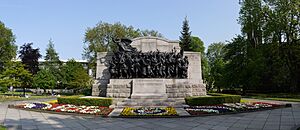Northumberland Fusiliers Memorial facts for kids
Quick facts for kids The Response 1914 |
|
|---|---|
| United Kingdom | |
 |
|
| For the Kitchener's Army "Pals" battalions of the Northumberland Fusiliers raised in World War I | |
| Unveiled | 5 July 1923 |
| Location | 54°58′43″N 1°36′46″W / 54.9786°N 1.6128°W
|
| Designed by | William Goscombe John |
|
|
|
Listed Building – Grade I
|
|
| Official name | The Response 1914 |
| Designated | 28 October 2014 |
| Reference no. | 1186201 |
The Response 1914 is a special war memorial located in Newcastle upon Tyne, England. It's also known as the Northumberland Fusiliers Memorial. You can find it in the public gardens near the Church of St Thomas the Martyr.
This memorial was created by Sir William Goscombe John. It was paid for by Sir George Renwick, 1st Baronet, and was officially shown to the public in 1923. The main purpose of the memorial is to remember the "Pals battalions" from the Northumberland Fusiliers. These were groups of friends and neighbours who joined the army together at the start of World War I in 1914. They were often called the "Commercials" because they were raised by the local Chamber of Commerce.
The memorial also celebrates Sir George Renwick's five sons, who all came home safely from the war. It also marks his 50 years working as a ship-owner. Sir George was also a Member of Parliament for Newcastle several times.
Contents
What Does the Memorial Look Like?
The memorial stands on a large base made of a strong stone called Shap granite. It has three steps leading up to a decorated platform and a wall. The whole base and its decorations are about 8 meters (26 feet) tall and 14 meters (46 feet) wide.
The Bronze Sculpture
The main part of the memorial is a large bronze sculpture. It is about 3 meters (10 feet) tall and 10 meters (33 feet) wide. This amazing sculpture shows many figures. You can see two young drummer boys and men saying goodbye to their families. The sculpture shows both pride in their country and sadness about leaving loved ones.
An angel, representing Renown (meaning fame or honour), flies above the crowd. She is blowing a trumpet. This scene reminds us of April 1915. That's when the 5th Northumberland Fusiliers marched along the Great North Road to Newcastle Station. They were heading off to war.
Carvings on the Back
On the back of the memorial, there are three figures carved into the granite. In the middle is St George, a famous saint. He stands on a special bracket shaped like two seahorses. On either side of St George are the symbols of Newcastle.
Two soldiers from the Northumberland Fusiliers stand next to St George. One soldier is dressed in the uniform from World War I. The other soldier wears the uniform from 1674, when the regiment was first formed. The area around the memorial used to be simple grass, but now it has colourful flower beds.
Messages and History
On the front of the memorial, there is a Latin message that says: Non sibi sed patriae. This means "Not for himself, but for his country". Below this, it says 'The Response 1914'.
On the back, another Latin phrase reads Quo fata vocant. This means "Whither the fates call" and is the motto of the Northumberland Fusiliers. There is also a longer message:
To commemorate the raising of the B Company 9th Battalion and the 16th, 18th and 19th Service Battalions, Northumberland Fusiliers, by the Newcastle and Gateshead Chamber of Commerce August–October 1914
The gift of Sir George Renwick Bt DL and Lady Renwick MCMXXIII
This message explains that the memorial remembers the different battalions (groups of soldiers) that were formed in 1914. It also states that the memorial was a gift from Sir George and Lady Renwick.
Unveiling and Recognition
The memorial was officially shown to the public on July 5, 1923. The Prince of Wales, who later became King Edward VIII, was there for the ceremony.
After being cleaned and repaired, the memorial was rededicated on October 25, 2007. Prince Philip, Duke of Edinburgh and some of the Renwick family's descendants attended this event. The memorial was first listed as an important historical building in 1971. In October 2014, it was given a higher status, becoming a Grade I listed building. This means it is considered a building of exceptional interest.
Images for kids




